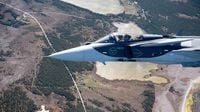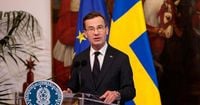Sweden is set to significantly increase its defense spending, aiming for a target of 3.5% of its GDP by 2030, marking the country's largest military expansion since the Cold War. This announcement comes from Prime Minister Ulf Kristersson, who emphasized the necessity of bolstering Sweden's military capabilities in response to shifting global security dynamics.
As tensions rise in Europe, particularly in light of the ongoing conflict in Ukraine and warnings from the United States regarding its diminishing role in European security, Sweden's government is adjusting its defense budget more aggressively than previously planned. Currently, defense spending is projected to reach 2.4% of GDP in 2025 and 2.6% by 2028. However, Kristersson noted that the government anticipates that NATO will soon establish a new spending goal for member states, ranging between 3% and 4% of GDP, prompting Sweden to aim for the midpoint of this range.
During a press conference held in Stockholm on March 26, 2025, Kristersson stated, "It is difficult to know exactly where it will land. We are pushing for it to be high enough to significantly increase the European NATO countries' ability to defend Europe." This shift in defense policy reflects a broader recognition among European nations of the need to enhance their military readiness in light of increased threats.
In addition to increasing defense spending, the Swedish government has also committed to ramping up its financial support for Ukraine. The 2025 budget allocation for aid to Ukraine will rise to 40 billion Swedish crowns (approximately $4 billion), a significant increase from the previously projected 25 billion crowns. This funding is intended to assist Ukraine in its ongoing struggle against the Russian invasion.
Sweden's military budget has doubled over the past four years, as the country seeks to reinforce a military that has been underfunded since the end of the Cold War. The government is now taking steps to ease budgetary constraints to facilitate this rearmament, similar to measures being undertaken by Germany. Kristersson remarked on the importance of adapting to a "new and far-reaching security policy situation," highlighting the need for both immediate and long-term decisions regarding Sweden's defense strategy.
To finance this ambitious rearmament plan, the Swedish government, alongside the anti-immigration Sweden Democrats, has agreed to raise loans totaling approximately 300 billion Swedish crowns over the next decade. This funding will help support the military's modernization efforts and ensure that Sweden can meet its new defense commitments.
In the context of trans-Atlantic relations, Kristersson expressed concerns about the current uncertainty, stating, "My view is that the stronger the European part of NATO becomes, the more interesting and important it will also be for the U.S. to cooperate across the Atlantic, and vice versa." This perspective underscores Sweden's commitment to strengthening its role within NATO and its partnership with the United States.
The announcement of increased defense spending comes amid a backdrop of heightened military activity and geopolitical tensions in Europe. The U.S. has previously urged NATO allies to boost their defense expenditures, with former President Donald Trump suggesting that member countries should aim for a spending target of 5% of GDP, significantly higher than the current 2% guideline.
Sweden's decision to increase its defense budget is not only a response to external pressures but also reflects a broader shift in public sentiment regarding national security. The Swedish population has become increasingly aware of the need for a robust military presence, particularly in light of recent conflicts in neighboring regions.
As Sweden embarks on this ambitious plan to enhance its military capabilities, the implications for regional security and NATO's collective defense posture will be closely monitored by both allies and adversaries alike. The commitment to raising defense spending to 3.5% of GDP by 2030 signals a significant pivot in Sweden's defense policy and its readiness to contribute more substantially to European security.
In conclusion, Sweden's proactive approach to defense spending highlights the evolving security landscape in Europe and the necessity for nations to adapt to new challenges. As the country prepares to invest heavily in its military, it aims to not only safeguard its own borders but also strengthen the collective security of the NATO alliance.





